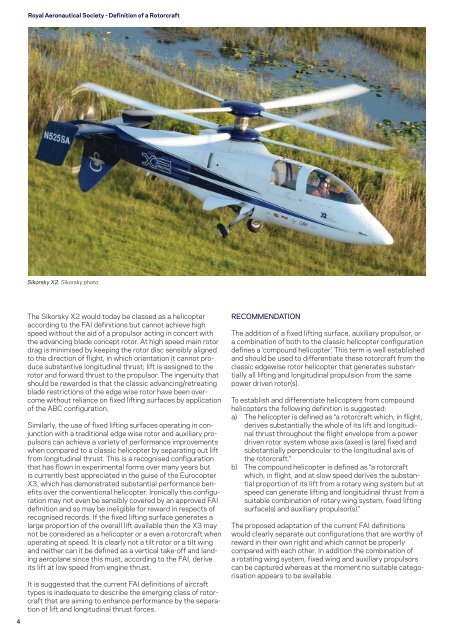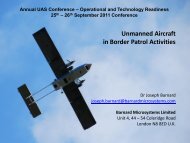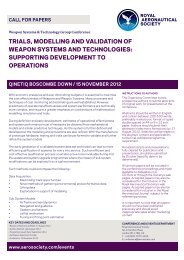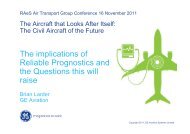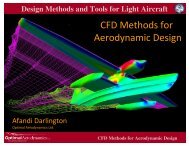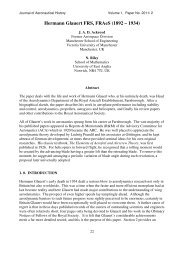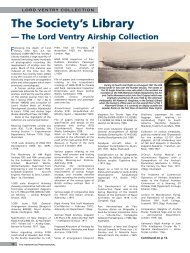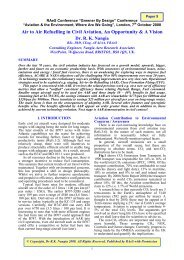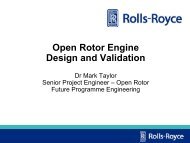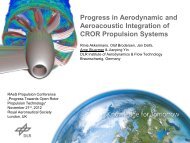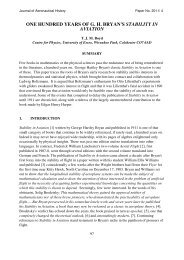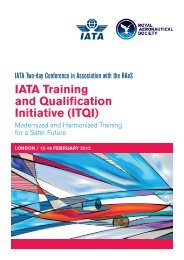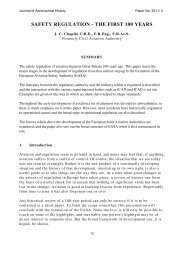DEFINITION OF A ROTORCRAFT - Royal Aeronautical Society
DEFINITION OF A ROTORCRAFT - Royal Aeronautical Society
DEFINITION OF A ROTORCRAFT - Royal Aeronautical Society
You also want an ePaper? Increase the reach of your titles
YUMPU automatically turns print PDFs into web optimized ePapers that Google loves.
4<br />
<strong>Royal</strong> <strong>Aeronautical</strong> <strong>Society</strong> - Definition of a Rotorcraft<br />
Sikorsky X2. Sikorsky photo.<br />
The Sikorsky X2 would today be classed as a helicopter<br />
according to the FAI definitions but cannot achieve high<br />
speed without the aid of a propulsor acting in concert with<br />
the advancing blade concept rotor. At high speed main rotor<br />
drag is minimised by keeping the rotor disc sensibly aligned<br />
to the direction of flight, in which orientation it cannot produce<br />
substantive longitudinal thrust; lift is assigned to the<br />
rotor and forward thrust to the propulsor. The ingenuity that<br />
should be rewarded is that the classic advancing/retreating<br />
blade restrictions of the edge wise rotor have been overcome<br />
without reliance on fixed lifting surfaces by application<br />
of the ABC configuration.<br />
Similarly, the use of fixed lifting surfaces operating in conjunction<br />
with a traditional edge wise rotor and auxiliary propulsors<br />
can achieve a variety of performance improvements<br />
when compared to a classic helicopter by separating out lift<br />
from longitudinal thrust. This is a recognised configuration<br />
that has flown in experimental forms over many years but<br />
is currently best appreciated in the guise of the Eurocopter<br />
X3, which has demonstrated substantial performance benefits<br />
over the conventional helicopter. Ironically this configuration<br />
may not even be sensibly covered by an approved FAI<br />
definition and so may be ineligible for reward in respects of<br />
recognised records. If the fixed lifting surface generates a<br />
large proportion of the overall lift available then the X3 may<br />
not be considered as a helicopter or a even a rotorcraft when<br />
operating at speed. It is clearly not a tilt rotor or a tilt wing<br />
and neither can it be defined as a vertical take-off and landing<br />
aeroplane since this must, according to the FAI, derive<br />
its lift at low speed from engine thrust.<br />
It is suggested that the current FAI definitions of aircraft<br />
types is inadequate to describe the emerging class of rotorcraft<br />
that are aiming to enhance performance by the separation<br />
of lift and longitudinal thrust forces.<br />
RECOMMENDATION<br />
The addition of a fixed lifting surface, auxiliary propulsor, or<br />
a combination of both to the classic helicopter configuration<br />
defines a ‘compound helicopter’. This term is well established<br />
and should be used to differentiate these rotorcraft from the<br />
classic edgewise rotor helicopter that generates substantially<br />
all lifting and longitudinal propulsion from the same<br />
power driven rotor(s).<br />
To establish and differentiate helicopters from compound<br />
helicopters the following definition is suggested:<br />
a) The helicopter is defined as “a rotorcraft which, in flight,<br />
derives substantially the whole of its lift and longitudinal<br />
thrust throughout the flight envelope from a power<br />
driven rotor system whose axis (axes) is (are) fixed and<br />
substantially perpendicular to the longitudinal axis of<br />
the rotorcraft.”<br />
b) The compound helicopter is defined as “a rotorcraft<br />
which, in flight, and at slow speed derives the substantial<br />
proportion of its lift from a rotary wing system but at<br />
speed can generate lifting and longitudinal thrust from a<br />
suitable combination of rotary wing system, fixed lifting<br />
surface(s) and auxiliary propulsor(s).”<br />
The proposed adaptation of the current FAI definitions<br />
would clearly separate out configurations that are worthy of<br />
reward in their own right and which cannot be properly<br />
compared with each other. In addition the combination of<br />
a rotating wing system, fixed wing and auxiliary propulsors<br />
can be captured whereas at the moment no suitable categorisation<br />
appears to be available.


